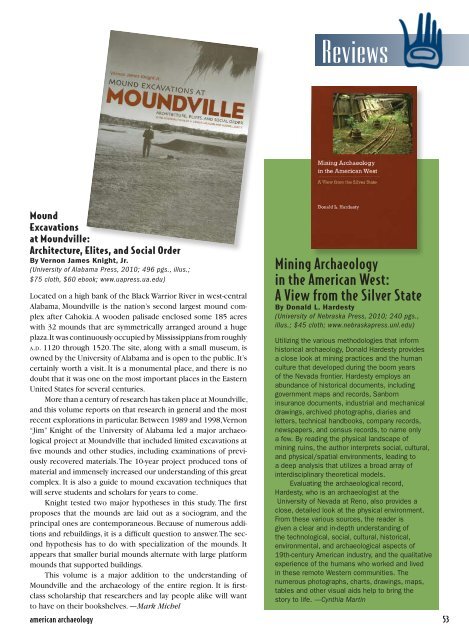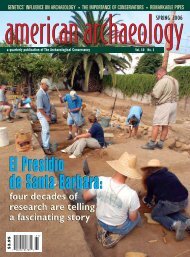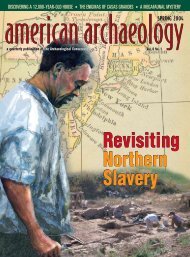Clovis Comet Debate - The Archaeological Conservancy
Clovis Comet Debate - The Archaeological Conservancy
Clovis Comet Debate - The Archaeological Conservancy
Create successful ePaper yourself
Turn your PDF publications into a flip-book with our unique Google optimized e-Paper software.
Mound<br />
Excavations<br />
at Moundville:<br />
Architecture, Elites, and Social Order<br />
By Vernon James Knight, Jr.<br />
(University of Alabama Press, 2010; 496 pgs., illus.;<br />
$75 cloth, $60 ebook; www.uapress.ua.edu)<br />
Located on a high bank of the Black Warrior River in west-central<br />
Alabama, Moundville is the nation’s second largest mound complex<br />
after Cahokia. A wooden palisade enclosed some 185 acres<br />
with 32 mounds that are symmetrically arranged around a huge<br />
plaza. It was continuously occupied by Mississippians from roughly<br />
a.d. 1120 through 1520. <strong>The</strong> site, along with a small museum, is<br />
owned by the University of Alabama and is open to the public. It’s<br />
certainly worth a visit. It is a monumental place, and there is no<br />
doubt that it was one on the most important places in the Eastern<br />
United States for several centuries.<br />
More than a century of research has taken place at Moundville,<br />
and this volume reports on that research in general and the most<br />
recent explorations in particular. Between 1989 and 1998, Vernon<br />
“Jim” Knight of the University of Alabama led a major archaeological<br />
project at Moundville that included limited excavations at<br />
five mounds and other studies, including examinations of previously<br />
recovered materials. <strong>The</strong> 10-year project produced tons of<br />
material and immensely increased our understanding of this great<br />
complex. It is also a guide to mound excavation techniques that<br />
will serve students and scholars for years to come.<br />
Knight tested two major hypotheses in this study. <strong>The</strong> first<br />
proposes that the mounds are laid out as a sociogram, and the<br />
principal ones are contemporaneous. Because of numerous additions<br />
and rebuildings, it is a difficult question to answer. <strong>The</strong> second<br />
hypothesis has to do with specialization of the mounds. It<br />
appears that smaller burial mounds alternate with large platform<br />
mounds that supported buildings.<br />
This volume is a major addition to the understanding of<br />
Moundville and the archaeology of the entire region. It is firstclass<br />
scholarship that researchers and lay people alike will want<br />
to have on their bookshelves. —Mark Michel<br />
Reviews<br />
mining Archaeology<br />
in the American West:<br />
A view from the silver state<br />
By Donald L. Hardesty<br />
(University of Nebraska Press, 2010; 240 pgs.,<br />
illus.; $45 cloth; www.nebraskapress.unl.edu)<br />
Utilizing the various methodologies that inform<br />
historical archaeology, Donald Hardesty provides<br />
a close look at mining practices and the human<br />
culture that developed during the boom years<br />
of the Nevada frontier. Hardesty employs an<br />
abundance of historical documents, including<br />
government maps and records, Sanborn<br />
insurance documents, industrial and mechanical<br />
drawings, archived photographs, diaries and<br />
letters, technical handbooks, company records,<br />
newspapers, and census records, to name only<br />
a few. By reading the physical landscape of<br />
mining ruins, the author interprets social, cultural,<br />
and physical/spatial environments, leading to<br />
a deep analysis that utilizes a broad array of<br />
interdisciplinary theoretical models.<br />
Evaluating the archaeological record,<br />
Hardesty, who is an archaeologist at the<br />
University of Nevada at Reno, also provides a<br />
close, detailed look at the physical environment.<br />
From these various sources, the reader is<br />
given a clear and in-depth understanding of<br />
the technological, social, cultural, historical,<br />
environmental, and archaeological aspects of<br />
19th-century American industry, and the qualitative<br />
experience of the humans who worked and lived<br />
in these remote Western communities. <strong>The</strong><br />
numerous photographs, charts, drawings, maps,<br />
tables and other visual aids help to bring the<br />
story to life. —Cynthia Martin<br />
american archaeology 53




